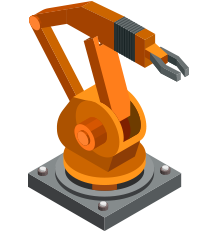The field of robotics is an area that fascinates millions of people. Technological advances happen continuously in every field, but robotics, in particular, is closely monitored by many who are eager to discover what's next. As a company that prides itself on being at the cutting edge of technological innovation, The Rodon Group is always up to date on the latest robotics trends, especially concerning plastic injection molding.
Robotics Predictions for 2022
Several areas of robotics are predicted to change throughout the upcoming year. The International Federation of Robotics has forecasted that two million new units of robots will be installed throughout industrial settings and factories around the world by the end of 2022. The programming and installation of these robots will be easier, with better-developed machine learning tools that facilitate self-optimized movements.
Robotics developers are looking to expand the range of collaborative applications they offer, enabling more applications for humans and robots to work alongside one another. Robots in these situations will be able to understand environmental cues and self-adjust, allowing for a highly responsive collaboration. Understanding factors such as human voice, gestures, and the intent behind movements are all robotic goals experts are currently developing.
Cloud technology and digital connection are expected to trend in robotics over the next year. Experts have developed a generic interface for industrial robots allowing them to connect with other industrial robots. The demand for autonomous mobile robots (AMRs) has increased significantly with the market expected to reach $7 billion in value by the end of 2022. 
The World Economic Forum predicts that the increased adoption of robotic solutions in industrial environments will create millions of new jobs. Specifically, AI learning specialists, data analysts, robotics professionals, process automation experts, and other similar roles will increase in demand. Meanwhile, information and data processing will be performed by automated technology. Robots are expected to replace many positions in factories, accounting firms, and other businesses involving cashier or secretarial work.
Robotics Trends in Plastic Injection Molding
Within the field of plastic injection molding, the role robotics will play in future applications is growing rapidly. Robotics innovations will alter the way high-volume plastic injection molding is performed in several ways. For example, injection molding robots provide significantly increased reach capabilities, both vertically and horizontally, and are highly flexible. These qualities allow them to be very time-efficient and increase the speed at which the injection molding process can be performed.
Increasingly, cobots, or computer-controlled collaborative robots, will be adopted for injection molding applications. Cobots handle highly repetitive tasks, such as loading and unloading injection molding machines while increasing workplace safety for human workers.
More companies will take advantage of mold flow analysis data, which is obtained through specialized software and simulates the injection molding cycle to predict how the mold will fill, which is highly beneficial during the design process. New software predicts how a mold will react to pressurized molten materials. This allows engineers to test for irregular fill patterns, shrinkage, warping, and more before beginning the prototyping phase.
Automation Trends and Benefits in Plastic Injection Molding
.jpg?width=303&name=5551%20(1).jpg)
The plastic injection molding industry is adopting automated solutions to increase production speed and precision. Typically, these automated systems are interconnected with a centralized control system. Analytics are generated that identify areas where improvements are possible and alert human operators when parts need inspection or repair.
Applications of automation in plastic injection molding include:
- Loading and Unloading: Robots reduce the amount of space needed to load and unload plastic injection molding machines and eliminate the risk of human error.
- Vision Inspection and Quality Control: With human oversight, robots can align parts and check them for defects.
- Secondary Processes: Robots can take on secondary processes such as decorating or labeling that are often required for molded parts.
- Assembling, Sorting, and Stacking: Robots can perform complex post-mold tasks like welding and arranging parts for kits or packaging.
Robotic automation systems for plastic injection molding applications are capable of running continuously, resulting in reduced lead times and labor costs. Automation also ensures the lowest possible error rate and reduces environmental impact. For plastic injection molding applications, some additional benefits of these trends include:
- Faster production times
- Reduced labor costs
- Lower overall production costs
- Increased sustainability in fabrication
- Better machine utilization
Automated Injection Molding From The Rodon Group
Robotics solutions are an important area of technological innovation. Each year advances in automation occur, bringing with them significant benefits for manufacturers and clients alike. The Rodon Group incorporates the height of technological advancement in its custom plastic injection molding solutions. We offer unmatched efficiency and quality for diverse industries at highly competitive prices. To learn more about our solutions, contact us or request a quote today.








Comments